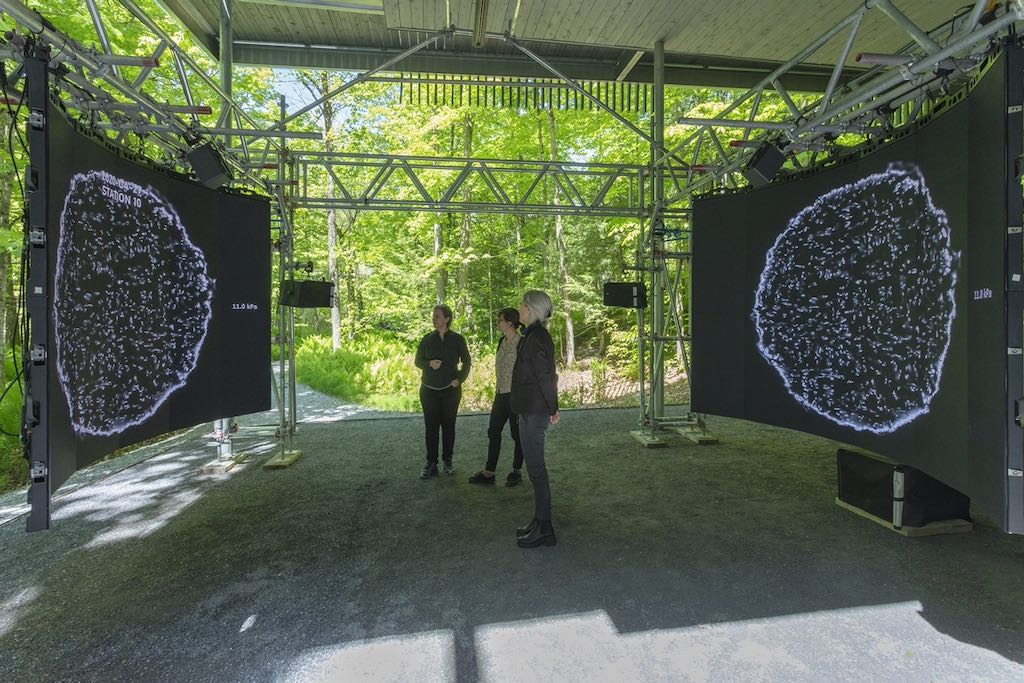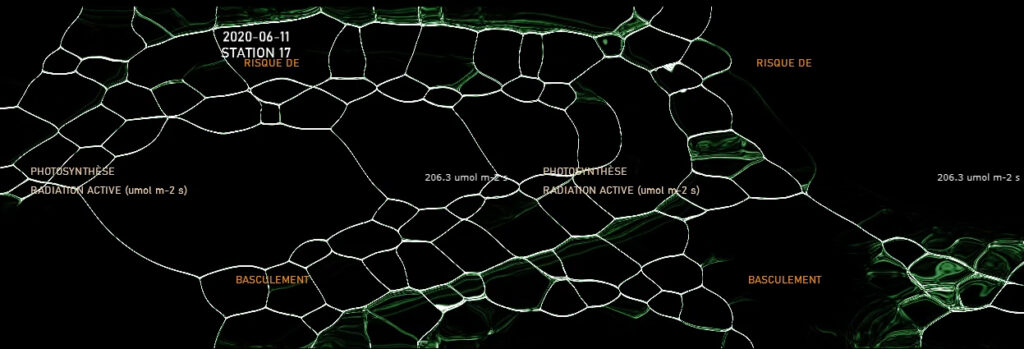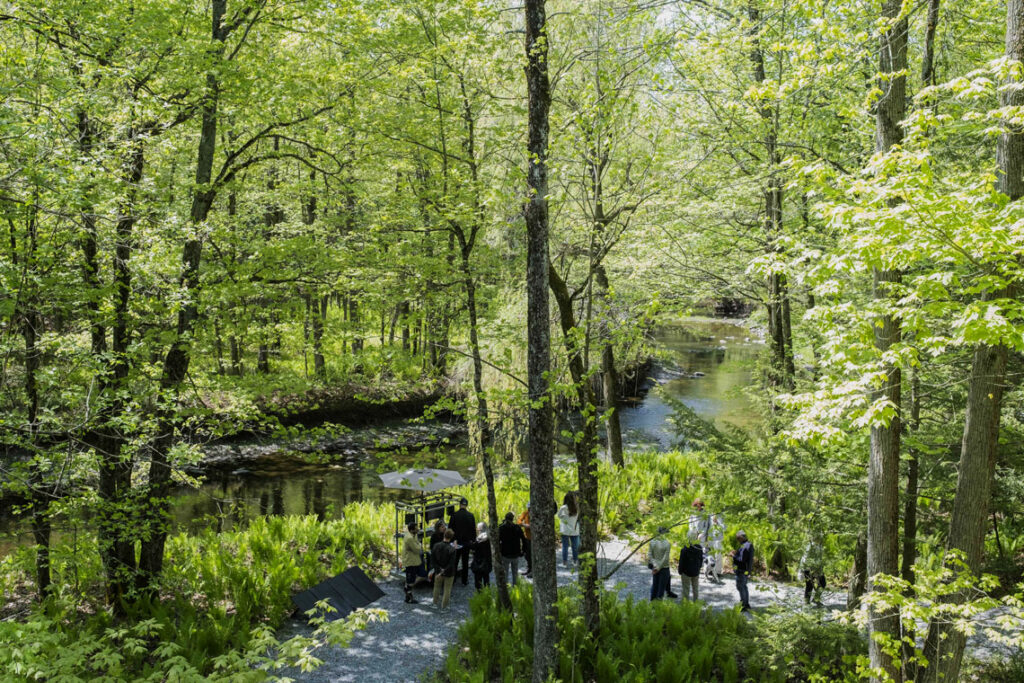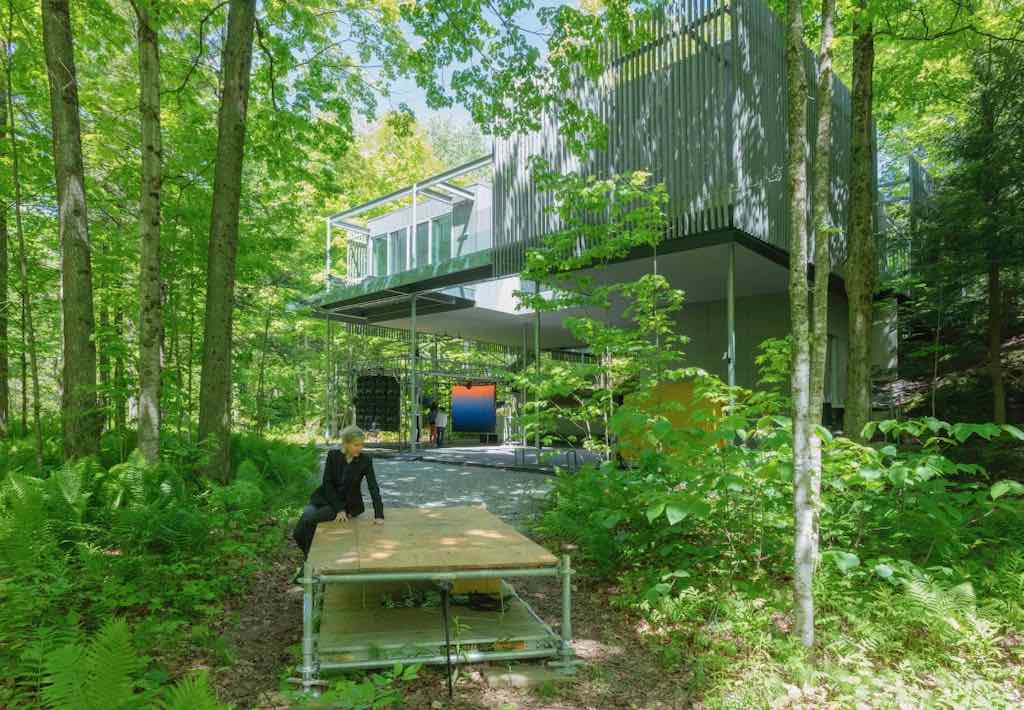On the exhibition Devenir hêtre (Becoming-Beech), Ælab at the Fondation Grantham pour l’art et l’environnement, Saint-Edmond-de-Grantham, May 11 to May 28, 2023
Formed by Gisèle Trudel and Stéphane Claude, the Ælab team designs installations integrating art and technology, in order to build bridges between different fields of research, notably science and academia. The duo also invites artists, poets and musicians to collaborate with them. Since 1996, the artists’ approach has creatively combined art and technology, whose definition goes beyond devices and processes, and highlights the specific affects and effects they produce, as well as the ways of being or doing associated with them.
Since 2020, as part of a collaboration between MÉDIANE(1) and SmartForests Canada(2), Ælab has been drawing on research in biology and forest ecology on Canadian forests to document nature’s means of adapting to climate change. In 2021, the wood-water-metal installation, created for the Arboretum of the Montreal Botanical Garden, remodels the meteorological and ecophysiological data of a sugar maple, an American beech and a balsam fir. In 2022, l’Orée des bois, presented on the lawn of UQAM’s Agora du Cœur des sciences, examines the growth of a yellow birch. At the Grantham Foundation, the third of these annual installations, devenir-hêtre, uses soil water potential measurements to demonstrate the ability of beech trees to absorb water and cope with short dry spells. In this way, beech trees prove to be less passive and more resilient to climate change than they first appear. The use of data intimately linked to the trees’ vital metabolism also gives them a certain agentivity in the shaping of the work, a situation recognized by Gisèle Trudel when she describes them as “actants”.

Collected by Blandine Courcot at the Station de biologie des Laurentides and edited by Marc-André Cossette and Gisèle Trudel, the data used in devenir-hêtre is projected onto two hemicycle screens, placed opposite each other and supported by a scaffolding structure. This device lends an immersive character to the presentation, which we perceive both physically and visually, underlining our embodied presence in the environment. The projection evolves: to the rather classical graphic representations – stick, curve and clock diagrams – are appended images evoking the root network, bark and leaves. A schematic section of a trunk and photographs of canopies taken at the Station de biologie des Laurentides using cameras attached to the trees also punctuate the presentation. Added to all this is a spatialized sound performance designed by Stéphane Claude, which accentuates the all-encompassing effects of the device and interferes with the sounds specific to the natural environment hosting the Foundation’s pavilion.

The ensemble provides a variety of embodied experiences of the intimate activity of the otherwise inaccessible forest, and acts as a counterpoint to the presentation of abstract ecophysiological data. As Bénédicte Ramade points out: “Trees, machines and humans join forces for the duration of an installation, a performance or an exhibition, in order to provide a different apprehension of climate statistics, beyond the usual schemas, while understanding the need to preserve an emotional relationship to the issue. »(3). Satellite activities are grafted onto the installation, including exchanges with artist Susan Turcot and the presentation of the Manicouagan Project, a collaboration between artists and researchers similar to this one. During the exhibition, the Mobile Climate Station, a mobile micro-version of the work Orée des bois, presented at UQAM’s Cœur des sciences the previous year, circulates in Drummondville. These outings provide an opportunity to capture local weather data and interact with audiences to discuss climate change. These multiple events give Devenir-Hêtre the role of a portal, stimulating and bringing together multiple exchanges and testimonies. In so doing, the artists explore the complex relationships between humans and the environment in today’s context.

Over time, the sites hosting these annual installations have become part of distinct institutional ecosystems: the Jardin botanique de Montréal, the Agora du Cœur des sciences de l’UQAM (a university scientific cultural center) and the Grantham Foundation (a private charity supporting art and art research in the context of current environmental challenges). In addition to their specific realities, these different terrains engage a variety of postures of observation and experimentation, making them also an object of study. This reveals the multiple attitudes and approaches adopted by individuals, groups and even institutions in their dealings with living things. Little by little, a community is created, mobilized by the awareness of belonging to the living world, and brought together by the desire to exchange ideas on this subject, in order to collectively assume the responsibilities that this awareness calls for.
- MÉDIANE. Chaire de recherche du Canada en arts, écotechnologies de pratique et changements climatiques.
- A scientific monitoring network for Canadian forests in the context of current environmental changes, equipped with high-precision equipment.
- Bénédicte Ramade, Art et environnement, une relation en profonde mutation, Esse, Webzine, august 2022. (In French)
Translated with DeepL.com (free version)

